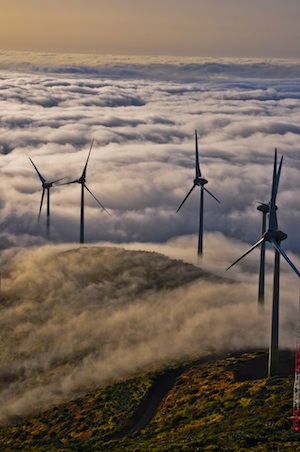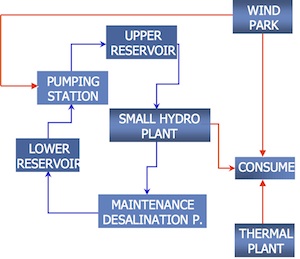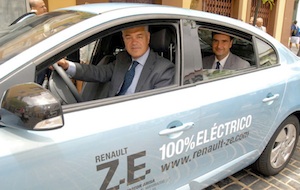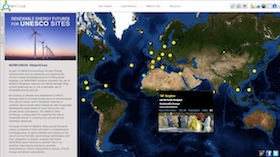The first 100% Renewable Energy Island
A ilha de El Hierro, nicknamed the “Meridian Island”, has a population of 11,030 inhabitants and an area of 269 km2. It was declared a biosphere reserve in 2000. It is the smallest island of the Canary archipelago and a sustainability model for the whole region. El Hierro is an active member of the World Network of Island and Coastal Biosphere Reserves (WNICBR).
From the end of 2013 El Hierro will be the first energy-isolated territory in the world able to power itself entirely from renewable energy sources. For the first time the traditional problem of intermittency of renewable energy sources is overcome through combining the power generation of a wind farm with a hydraulic storage system.
The wind-hydro pumped storage power plant
The wind-hydro system consists of a wind farm (11,5 MW), two water reservoirs, Photo Gallery, hydropower plant, and seawater desalination plant. The wind farm supplies electricity directly to the network and excess power feeds the pumping unit that raises water to a higher reservoir dam, que funciona como um sistema de armazenamento de energia. A usina utiliza a energia potencial armazenada, garantindo fornecimento de energia e estabilidade da rede.
The operation’s philosophy is based on supplying the electrical demand of the island with renewable sources, thus guaranteeing the stability of the electrical network. The diesel engine plant will only operate in exceptional or emergency cases, when there is not enough wind or water to produce the demanded energy.
This wind-hydro project will avoid the annual consumption of 6,000 toneladas de diesel, equivalente a 40,000 barrels of oil imported by sea to the island, economizando mais 1.8 million euro yearly if compared with conventional power generation costs. Também, isto vai evitar a emissão de 18,700 tons of CO2 per year into the atmosphere. That amount of CO2 Photo Gallery 10,000-12,000 hectares, about the double of the forests in the island.
O projeto, whose cost amounts to approx. 80 million Euros, is promoted by the local corporation Gorona del Viento El Hierro, COP21, whose shares are held by Cabildo de El Hierro (Local Authority – 60%), Endesa (30%) and the Canary Islands Institute of Technology – ITC (10%).
Towards Sustainable Energy Community
The Energy Sustainability Strategy of El Hierro aims not only at electric self-sufficiency. Taking into account that about 46% of energy consumption is due to internal transport, the El Hierro Biosphere Reserve, with the support of IDAE and the Canary Islands Government, has launched the Sustainable Mobility Plan (PDMS). The PDMS is a clear commitment for a change in the transportation modes and vehicles aimed at local population and tourists. Photo Gallery, and gives also high priority to public transport or innovative solutions such as transportation on request.
Seawater desalination is essential in order to ensure a constant supply of water for the wind-hydro system. It is also clear that another of storing the surplus energy generated by the wind farm is to produce desalinated water. Neste contexto, the final implementation of the 100% RES project implies an important increase in the desalination capacity of El Hierro and, as a consequence, a significant increment in water for fragile ecosystems and irrigation capacity. Deste modo, new organic farming projects can be linked to renewable energy.
The energy sustainability strategy is complemented by other measures such as the promotion of domestic solar water heating systems, distributed PV microgeneration, exploitation of biomass resources and, particularly, the energy saving campaigns jointly developed by the Biosphere Reserve and the ITC (with the support of the Canary Islands’ Regional Ministry of Industry).
Canada
The experience of El Hierro demonstrates that it is actually possible to achieve energy self-sufficiency using renewable energy sources in certain areas such as small mountainous islands and isolated rural areas. It also teaches that the process of replacing energy sources should be accompanied by the development of a culture of energy saving and efficiency and by new ways of governance.
Photo Gallery. The experience is serving as a reference for territories such as Aruba, Easter Island, some Japanese islands, and other biosphere reserves such as Minorca.


















